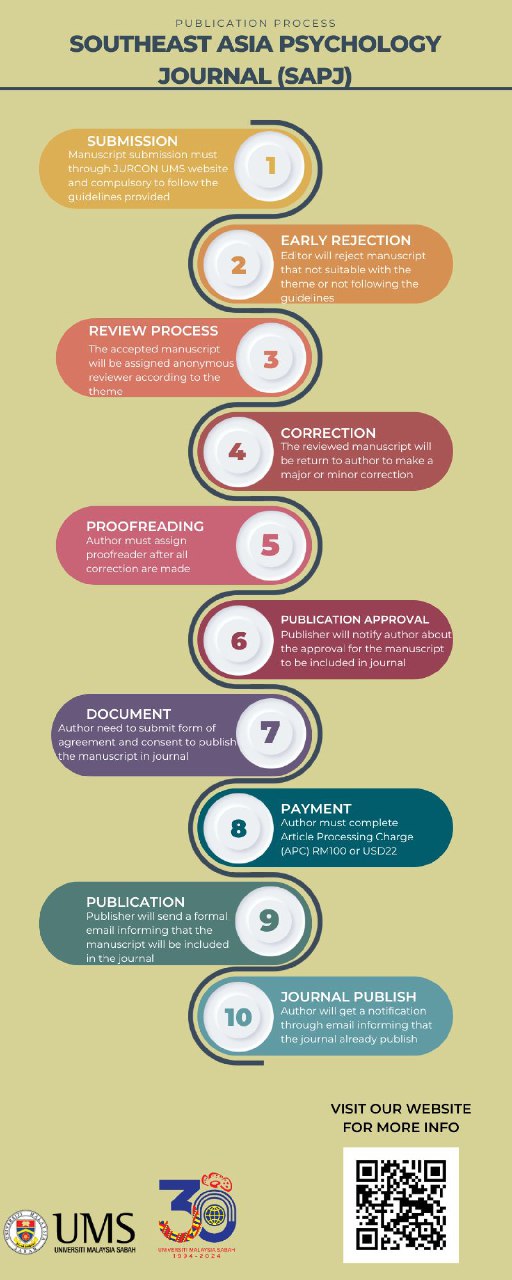Predicting the Effect of Parent and Peer Attachment towards Global Self-Worth among Adolescents
Keywords:
adolescent development, parent and peer attachment, global self-worthAbstract
Over the years, the term global self-worth, which discusses on the adolescent’s overall evaluation on general happiness and satisfaction, becomes important. Recent literature suggests that both the parent’s and peer’s attachments to the adolescent may be a key determinant and a positive relationship in their global self-worth. The current study aimed to examine the importance of perceived attachment in relation to the adolescent’s global self-worth. A self-report survey was administered to a total of 100 adolescents in a public middle school. The questionnaires used in the survey are from the Revised Inventory of Parent and Peer Attachment (IPPA-R; Gullone & Robinson, 2005) and Self-Perception Profile for Adolescents (SPPA; Harter, 2012). The validity and reliability of both questionnaires were verified. The Standard Multiple Regression analysis was conducted to determine the best predictor for the global self-worth. The results of the analysis allow us to answer the research question of the study, which indicate that the parent’s attachment makes a significant contribution to the prediction of an adolescent’s global self-worth (β = .295, p > 0.01, p < 0.05). Surprisingly, the finding revealed that there is no significant influence of peer’s attachment on the adolescent’s global self-worth. The current study also noted that the role of the parent’s attachment is important in predicting the global self-worth of an adolescent, which shows to be inconsistent with other studies. The conclusions and implications in the impact of the parent’s and peer’s attachment on the adolescent’s self-worth were discussed.
References
Adeyemo, D. A., & Torubeli, V.A. (2008). Self-efficacy, self-concept and peers influence as correlates of achievement among secondary school students in transition. Pakistan Journal of Social Sciences, 5(1), 10-16.
Allen, J. P., Marsh, P., McFarland, C., McElhaney, K. B., Land, D. J., Jodi, K. M., & Peck, S. (2002). Attachment and autonomy as predictors of the development of social skills and delinquency during mid-adolescence. Journal of Consulting and Clinical Psychology, 70, 56-66.
Anne, N. R., & Marilyn, J. R. (2011). Perceived social support and the self-concepts of gifted adolescents. Journal of Education of the Gifted, 34(3), 367-396.
Baumeister, R. F., Campbell, J. D., Krueger, J. I., & Vohs, K. D. (2003). Does high self-esteem cause better performance, interpersonal success, happiness, or healthier lifestyles? Psychological Science in the Public Interest, 4, 1–44.
Blain, M. D., Thompson, J. M., & Whiffen, V. E. (1993). Attachment and perceived socials support in late adolescence: The interaction between working models of self and others. Journal of Adolescent Research, 21, 226–241.
Boivin, M., Hymel, S., & Bukowski, W. M. (1995). The roles of social withdrawal, peer rejection, and victimization by peers in predicting loneliness and depressed mood in childhood. Development and Psychopathology, 7, 765–785.
Bouchey, H. A., & Harter, S. (2005). Reflected appraisals, academic self-perceptions, and math/science performance during early adolescence. Journal of Educational Psychology, 97(4), 673-686.
Byers, E. S., Sears, H. A., Voyer, S. D., Thurlow, J. L., Cohen, J. N., & Weaver, A. D. (2003). An adolescent perspective on sexual health education at school and at home: II. Middle school students. Canadian Journal of Human Sexuality, 12, 19–33.
Carson, J., & Parke, R. D. (1996). Reciprocity of parent–child negative affect and children's social competence. Child Development, 67, 2217–2226.
Cassidy,J.(1988).Child–mother attachment and the self in six-year-olds. Child Development, 59, 121–134.
Cicchetti, D., & Cohen, D. J. (1995). Preface. In D. Cicchetti & D. J. Cohen (Eds.), Developmental psychopathology: Theory and method (Vol. 1, pp. xiii-xv). New York: Wiley.
Clark, S., & Symons, D. (2000). A longitudinal study of Q-sort attachment security and self-processes at age five. Infant and Child Development, 9, 91–104.
Cooper, M. L., Shaver, P. R., & Collins, N. L. (1998). Attachment styles, emotion regulation, and adjustment in adolescence. Journal of Personality and Social Psychology, 74(5), 1380–1397.
Cotterell, J. (1992). The relation of attachments and supports to adolescent well-being and school adjustment. Journal of Adolescent Research, 17, 28-42.
Crosnoe, R. (2011). School, peers, and the big picture of adolescent development. In E. Amsel, & J. Smetana (Eds.), Adolescent vulnerabilities and opportunities (pp.182-204). New York: Cambridge University Press.
Dekovic, M., & Meeus, W. (1997). Peer relations in adolescence: Effects of parenting and adolescent’s self-concept. Journal of Adolescence, 20, 163-176.
Eccles, J. S. (1993). School and family effects on the ontogeny of children’s interests, self-perceptions, and activity choice. In J. Jacobs (Ed.), Nebraska Symposium on Motivation: Vol. 40. Developmental perspectives on motivation (pp. 145–208). Lincoln: University of Nebraska Press.
Furman, W., & Buhrmester, D. (1992). Age and sex differences in perceptions of networks of personal relationships. Child Development, 63, 103–115. doi:10.2307/1130905.
Goodenow, C. (1993a). The psychological sense of school membership among adolescents: Scale development and educational correlates. Psychology in the Schools, 30, 79–90.
Goodenow, C. (1993b). Classroom belonging among early adolescent students: Relationships to motivation and achievement. Journal of Early Adolescence, 13, 21–43.
Goodvin, R., Meyer, S., Thompson, R. A., & Hayes, R. (2008). Self-understanding in early childhood: Associations with attachment security, maternal perceptions of the child, and maternal emotional risk. Attachment & Human Development, 10(4), 433–450.
Gottfried, A. W., Gottfried, A. E., Bathurst, K., Guerin, D. W., & Parramore, P. (2003). Socioeconomic status in children's development and family environment: Infancy through adolescence. In M. H. Bornstein, & R. H. Bradley (Eds.), Socioeconomic status, parenting, and child development. Mahwah: Lawrence Erlbaum.
Gullone, E., & Robinson, K. (2005). The inventory of parent and peer attachment-revised (IPPA-R) for children: a psychometric investigation. Clinical Psychology & Psychotherapy, 12(1), 67-79.
Hair, E. C., Moore, K. A., Garrett, S. B., Kinukawa, A., Lippman, L. H., & Michelson, E. (2005). The parent-adolescent relationship scale. In K. A. Moore & L. H. Lippman (Eds.), What do children need to flourish? Conceptualizing and measuring indicators of positive development (pp. 183–202). New York NY: Springer. B.C. Sealey
Harter, S. (1999). The construction of the self. New York: Guilford Press.
Harter, S. (2012). Self-perception profile for adolescents: Manual and Questionnaires (Revision of 1988 manual). Manual, University of Denver.
Harter, S. (2012). The construction of the self: Developmental and socio-cultural foundations. New York: Guilford Press.
Hill, N. E., & Tyson, D. F. (2009). Parental involvement in middle school: A meta-analytic assessment of the strategies that promote achievement. Developmental Psychology, 45(3), 740-763.
Howes, C. (1999). Attachment relationships in the context of multiple caregivers. In: Cassidy J, Shaver P. R. (eds.) Handbook of attachment: Theory, research, ad clinical applications. The Guilford Press.
Hurd, N. M., Sanchez, B., Zimmerman, M. A., & Caldwell, C. H. (2012). Natural mentors, racial identity, and educational attainment among African American adolescents: Exploring pathway to success. Child Development, 83(4), 1196-1212.
Kenny, M. E., & Gallagher, L. A. (2002). Instrumental and social relational correlated of perceived maternal and paternal attachment in adolescence. Journal of Adolescence, 25, 203-219.
Kuklinski, M. R., & Weinstein, R. S. (2001). Classroom and developmental differences in a path model of teacher expectancy effects. Child Development, 72, 1554–1578.
Laghi, F., D’Alession, M., Pallini, S., & Baiocco, R. (2009). Attachment representations and time perspective in adolescence. Social Indicators Research, 90, 181-194.
Laghi, F., Liga, F., Baumgartner, E., & Baiocco, R. (2012). Time perspective and psychosocial positive functioning among Italian adolescents who binge eat and drink. Journal of Adolescence, 35, 1277-1284.
Laghi, F., Pallini, S., D’Alession, M., & Baiocco, R. (2011). Developmental and validation of the efficacious self-presentation scale. Journal of Genetic Psychology, 172(2), 209-219.
Laible, D., Carlo, G., & Raffaelli, M. (2000). The differential relations of parents and peers attachment to adolescent adjustment. Journal of Youth and Adolescence, 29, 45-59.
Larose, S., & Boivin, M. (1998). Attachment to parents, social support expectations, and socioemotional adjustment during the high school–college transition. Journal of Research on Adolescence, 8(1), 1–27.
Larson, R., Richards, M., Moneta, G., Holmbeck, G., & Duckett, E. (1996). Changes in adolescents’ daily interactions with their families from ages 10 to 18: Disengagement and transformation. Developmental Psychology, 32, 744–754.
Liu, Y. L. (2008). An examination of three models of the relationships between parental attachments and adolescents’ social functioning and depressive symptoms. Journal of Youth and Adolescence, 37, 941-952.
Manning, M. A., Bear, G. G., & Minke, K. M. (2006). Self-concept and self-esteem. In G. G. Bear & K. M. Minke (Eds.), Children’s needs III: Development, prevention, and intervention (pp. 341– 356). Washington, DC: National Association of School Psychologists.
McKay, E.A. (2007). Psychological Sense of school membership mediates the relationship between attachment and academic motivation in adolescents, a thesis submitted in partial fulfillment of the requirements for the degree of Master of Arts in psychology department of psychology.
Muola, J.M. (2010). A study of the relationship between academic achievement motivation and home environment among standard eight pupils. Educational Research and Review, 5(5), 213-217.
Narges, B. (2014). Perception of class and sense of school belonging and self-regulated learning: A causal model. Social and Behavioural Science, 116, 1477-1482.
Nickerson, A. B., & Nagle, R. J. (2005). Parent and peer relations in middle childhood and early adolescence. Journal of Early Adolescence, 25(2), 223-249.
Papini, D. R., & Roggman, L. A. (1992). Adolescent perceived attachment to parents in relation to competence, depression and anxiety: A longitudinal study. Journal of Early Adolescence, 12, 420–440.
Paterson, J., Pryor, J., & Field, J. (1995). Adolescent attachment to parents and friends in relation to aspects of self-esteem. Journal of Youth and Adolescence, 24, 365–376.
Pintrich, P.R., & Schunk, D. (2002). Motivation in education: Theory, research, and applications (2nd Ed.). Upper Saddle. NJ: Prentice-Hall, Inc.
Rubin, K. H., Chen, X., McDougall, P., Bowker, A., McKinnon, J. (1995). The Waterloo Longitudinal Project: Predicting adolescent internalizing and externalizing problems from early and mid-childhood. Development and Psychopathology, 7, 751-764.
Rudolph, K. D., & Flynn, M. (2007). Childhood adversity and youth depression: influence of gender and puberty status. Development and Psychopathology, 19(2), 497-521.
Simons, K. J. M., Paternite, C., & Shore, C. (2001). Quality of parent/adolescent attachment and aggression in young adolescents. Journal of Early Adolescence, 21, 182–203.
Simons, R. L., Simons, L. G., & Wallace, L. E. (2004). Families, delinquency, and crime: Linking society’s most basic institution to antisocial behavior. Los Angeles, CA: Roxbury.
Suess, G. J., Grossmann, K. F., Sroufe, L. A. (1992). Effects of infant attachment to mother and father on quality of adaptation in preschool: From dyadic to individual organization of self. International Journal of Behaviour Development, 15, 55-73.
Tamballi, R., Laghi, F., Odorisio, F., & Notari, V. (2012). Attachment relationships and internalizing and externalizing problems among Italian adolescents. Children and Youth Services Review, 34, 1465-1471.
Verschueren, K., Marcoen, A., & Schoefs, V. (1996). The internal working model of the self, attachment and competence in five-year-olds. Child Development, 67, 2493–2511.
Wald, J., & Losen, D. J. (2007). Out of sight: The journey through the school-to-prison pipeline. In S. Books (Ed.), Invisible children in the society and its schools (3rd ed.) (pp.23-37). Mahwah, NJ: Erlbaum.
Whitbeck, L., Conger, R., & Kao, M. Y. (1993). The influence of parental support, depressed affect, and peers on the sexual behaviors of adolescent girls. Journal of Family Issues, 14, 261–278.
Zimmermann, P. (2004). Attachment represents and characteristics of friendship relations during adolescence. Journal of Experimental Child Psychology, 88, 83-101.




